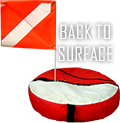The Search for Calypso (or adventures with dive boats) by Bob Libbey
The Search for Calypso (adventures with dive boats)
When asked about scuba diving, anyone old enough might think of Jacques Cousteau. He was a pioneer of the sport. But let's not forget the Calypso. Jacques was always on the hunt for some elusive creature or another, and the Calypso was always there. If Jacques was the Lone Ranger, the Calypso was his trusty steed, Silver. It was indispensable to what he accomplished getting him where he needed to be. When we were dive certified, we too wanted a great dive boat. It just took some experimenting . . .
The ideal dive boat might be something like what you see on vacation in the Caribbean. It fits twenty to fifty people comfortably. It has a staircase where you can walk right into the water. It has places to strap tanks into the boat so that they will not shift and fall. It has great seating for gearing up. It has a refrigerator stocked to the gills with tasty beverages. It has a bathroom! Now let's get real. We couldn't afford that boat and even if we could it would be impractical and wasteful for a few guys to be using it. So, we've had a few adventures looking for the right boat or using the one that was available. Some of this stuff was not very funny at the time. I'm hoping that looking back, it will all seem entertaining.
THE BIG RESORT DIVE BOAT
After our marriage, my parents generously sent my wife Sara and I on a honeymoon to Aruba. Yes, it is a beautiful island off the coast of Venezuela with fine white sandy beaches. The reef structure, however, is not very impressive. On the flight down, my newlywed bride had some sinus problems in the plane. Although she was dive certified, the sinus issue curtailed her ability to equalize underwater. This kept her mostly landlocked. I, however, still wanted to get some dives in. I went with a large group to the far side of the island on a big dive boat. These dives were set up by the resorts to be easy going and safe for newly certified resort divers. On my earlier group dives, I was coming back with 1,000 to 1,400 p.s.i. remaining in my tank. This amounts to at least one third of the original tank fill. To me, this is a loss of potential bottom time. For the resorts, this was exactly what they wanted; nice, and safe, and easy. However, I was feeling a little under-challenged. After we finished the pre-dive planning and suited up, people began to line up for the easy walk-in access to the ocean off the back of the boat. I didn't much want to wait in line to get in the water. I didn't really know anybody and I had no buddy to help out. So, I thought a more advanced entry might be fun. I perched myself up on the outside ledge of the boat and prepared for a seated entry, flopping backwards (tank first) into the water. Jacques would be proud. The biggest catch that I could see was that the outside ledge was above the seated area and it was fairly high off of the water. I'm guessing at least six to eight feet up. But hey, I wanted adventure for myself. No one else was even looking. I put my mask on, grabbed and held my regulator in my mouth, secured my hoses with my other hand, and without fanfare, flopped over backwards. Mid air, I had that awkward sensation of falling backward fast. When I hit the water, I hit hard. It was like getting hit by a linebacker at a full run while you were still reaching up to catch the pass. I oriented myself and found no apparent injuries or problems. Okay. So, now I can put my mask on and look around at fish while I wait for the group. Hang on. I had my mask on when I dropped! It fell off and sank thirty feet to the bottom! Now what? I didn't know anybody and no one was even paying attention to me. I started to call up to people on the boat. I managed to get someone's attention and they lent me their mask. I quickly put it on. With ocean visibility I could see my mask on the bottom from the surface. I sank right down on it and came right back up. I returned the mask I had borrowed with many thanks. I rejoined the group with no one the wiser. Even with my extra bottom trip, I finished with over one third of my tank's air remaining. But I guess I earned the adventure that I asked for with my fantastic reverse seated entry.
THE PEDAL BOAT
A word to the wise, do not try this at home. Do not ever try to scuba dive off of a plastic pedal boat. If you ever get tempted to do it, listen to me now, don't. If you just swim from shore, you will save yourself a lot of hassle. I know, I'm ashamed to admit that I've tried it. It was not smart but we didn't plan to dive off of that thing, it just worked out that way.
Shortly after certification, Steve and I wanted to try some night dives. We drove out to our parent's house on Pike Lake near Hartford. We were excited to see the underwater world at night. We would be diving off of the pontoon boat. It has a nice big area for suiting up, it is very sturdy, and it has easy entry access to the water. When we arrived, we were informed that the boat wasn't operating correctly. However, we were already there and we had done all of our gear preparation. Heck. We were going. We tied an anchor to the recreational pedal boat, threw our gear in and headed out. I have no idea what the weight limit on that boat is, but I am reasonably sure that we were way above it. We had two adult males with tanks, gear and lead sinking weights. It didn't take very long to see that this boat was not working correctly. If you have ever enjoyed a ride on a pedal boat, you can appreciate that it is a boat made for leisure travel. Even in ideal conditions, they don't go very fast and they don't steer very well. When it was over-weighted, everything operated worse. For some reason, the paddle wheel was not engaging the water. We kept shifting our bodies around trying to pedal leaning forward or crouching over the pedals. Nothing helped. It felt like we were just spinning the paddle without moving the boat. The lethargic steering barely acknowledged direction changes with tiny turns in gradual increments long after you made the steering changes. We had planned to dive fairly far from the house, but we realized that this boat wouldn't get us there. We dropped anchor about one quarter mile from the house and prepared to go diving. We left a light on the boat so that other boaters would not run into the pedal boat. Then we threw our gear into the water to suit up.
At this early stage, I was using a second hand (old) Bouyancy Control Device ("BCD") that had a separate weight belt. While trying to put it on that day, I couldn't get it to snap shut. Steve was waiting for me patiently, but I just couldn't get it to lock on. He let his dive flag to go to help me out. He was thinking that we'd swim and catch up to it in a minute. The wind was blowing directly the opposite direction as the way back to our parent's home would be. Steve accidentally dropped his mask and it sank. He borrowed mine and went down to find his. When he came back, I still couldn't click the belt shut. Steve suggested submerging to the bottom and clamping the belt on like we had been taught in dive training in the swimming pool. We sank down but I still couldn't get it. After several minutes working face down in the silt, Steve was getting concerned and signaled a return to the surface. When we came up, the boat was gone. I think I had tied a few slip-knots to hold the anchor on and the knots didn't hold. The boat had already drifted fifty to seventy five feet away. I finally realized that a lead weight had shifted on the belt and was blocking the closure mechanism. I'm sure that they told us in class to watch for this, but it had never yet happened to me. I finally fixed the belt. We set a compass heading to match the direction of the wind and began to dive in earnest. We thought that we'd ‘shadow' the drift of the boat at the bottom.
At night many fish are resting underwater. With our bright dive lights, these sedentary fish reflect light like a mirror at the bottom. We saw a large Northern Pike glistening brightly before it darted off. After a few minutes, we thought that it would be smart to check the progress of the boat. Maybe we'd see how much we had caught up to it. When we surfaced, we could see a tiny dot of light a long long way away. Okay. We finally came to our senses and reached the conclusion that this was just one of those days where nothing was going right. We gave up on the dive and started swimming towards the boat. I'm guessing that it took us about fifteen minutes to catch it. We were now three quarters of the way to the other side of the lake. We tried half-heartedly to get in with our gear. We soon found that it would be almost impossible to climb in and load our gear without sinking the boat. We resigned ourselves to the fact that we were going to have to tow this thing all the way home by swimming it back. We swam and we swam. Our backs were down, our eyes looking up at the stars. We had no real land references in the dark. We kicked and we kicked and we kicked. To the extent that we were moving at all against the wind, it was impossible to tell. I suddenly decided to climb in with my gear still on. I would just pull myself up. This would get the gear on-board and we could pedal on home. I pulled myself up over the front and the pedal wells sank down and filled completely with water. I gave up and started swimming again. Now we were towing a much heavier boat. To Steve's credit, he never once complained that I made the job harder. He just kept swimming and swimming and swimming. After an endless swim, hours long, we finally returned to shore. We'd lost the anchor and the dive float but we were home. I spent the night at my folk's house and woke up early to recover the flag we'd lost. I learned some valuable lessons that day. Firstly, the fish you see diving are bigger than the ones you catch while fishing. Secondly, when I decided to upgrade my scuba gear, I needed to make sure that my BCD had an integral weight system. And lastly, never ever never dive off of a pedal boat when you can swim from shore.
THE TWELVE FOOT ROW BOAT
We knew early on that we would need a decent dive boat. This would definitely not be a boat with foot pedals. When a friend's twelve foot row boat came up for sale, we bought it. It even had a three horsepower motor. It could only putt putt across a lake but it would get us there and then, we were in business. The boat had one great feature. It could fit in the back of my pick-up truck. I could take it to a lake without a trailer and launch it right off the end of the truck. The weight limit on the boat was 450 pounds. Combined, Steve and I were close to that weight without gear. Sometimes we'd throw two or three tanks apiece in there plus all of the weights and dive accessories. Needless to say, we were cruising low. The little motor would run out of gasoline after about a mile as a crow flies. So, we would take a small bottle of gas and oil mix to get home.
One day on Pewaukee Lake, we went out with two tanks each. As usual, the waves were breaking over the edge of the boat. We came prepared for this eventuality. One person drove while the other bailed out water with a cup. Then it happened. We were about half way to where we wanted to be when a large boat came by. If you've ever been on it, you know that Pewaukee Lake is the place to regularly see huge boats. This one wasn't one of the biggest. It was just some over sized Bayliner type of craft. They even waved at us as they went past. They sent about a two foot high displacement wave right towards the side of our boat. We were two inches off the water. The boat took on the whole wave like we were in the Poseidon adventure. We did our best balancing act not to capsize. In one quick shot, we were about half full to the top with water. Everything buoyant in the boat was floating. We immediately turned and made haste for the nearest shore. Once shallow enough, we unloaded all of our gear and lifted the boat up dumping out all of the water. We made the decision not to continue onward. Instead, we dove right where we were to avoid the risk of getting sunk.
One interesting thing about this boat was that we could never suit up inside it. It was too unstable. While one person was getting ready, the other would need to grab the sides and hang on. If you tried to drop into the water with your gear on, you would likely capsize the boat. So, we would inflate our BCDs and throw our gear overboard. Then we'd jump in carefully and put the gear on in the water. Eventually, this became second nature.
Later, when we went on a tropical dive trip to Cozumel, we had a nice diveboat to dive off of (maybe twenty five feet). (Yes, Cozumel does have some very nice reef structure). Nonetheless, we did what we were accustomed to doing. We all threw our gear in the water and bing-bang-done, suited up like it was nothing. Our local dive guide was shocked. He'd never seen anyone do that, much less a whole group. And even then, you would expect that someone who is doing things differently would be doing things inefficiently. I'm sure he was expecting us to struggle and need help but thanks to the twelve foot rowboat, we were ready to dive almost as soon as we hit the water.
It is fairly easy to see a problem with this method of entry. We would put heavy weights in our BCDs to go under. If you didn't inflate it properly when you threw your gear over, it could sink before you put it on. We kept tethers hanging over the side of the boat to prevent this from happening. However, one time Steve's gear was not tethered and it sank. He had blown air into his BCD, just not enough to keep it afloat. My first order of duty was to find it right away. Visibility was very poor. I couldn't see my hand in front of my face. It was also a windy day. We were anchored but the boat was swinging back and forth from the fixed anchor point. It was an area that was only ten to twelve feet deep. Nonetheless, I was having trouble locating the BCD. Steve, who had full confidence in me finding it at first, rapidly began to panic. I had gone under several times and swam around a bit. From the surface, Steve could see that I was swimming off of the ideal search area but he had no way to communicate that to me at the bottom. I'd surface, come closer to the boat and try again. Finally, Steve tired of watching. He jumped in and tried to swim down holding his breath. Right after he started doing this, I found the BCD and brought it back up. His faith in me was restored!
OUR ULTIMATE DIVE BOAT
We tried nearly every kind of boat searching for a great dive boat. We tried speed boats, pedal boats, rowboats, canoes, pontoon boats, and resort dive boats each in all different sizes and types. After experimenting with speed boats that had a "V" shaped hull, we concluded that we needed to go wider and flatter for stability. Steve and I pooled our resources and bought an eighteen foot (huge by our standards) duck boat with heavy welded ribs. It is eighty seven inches across from side to side! Our tiny three horsepower motor was upgraded to a fifty horse Mercury. Our parents next contributed a nice feature. They saved the boards from an old redwood deck that was replaced. The gave us the lumber for our boat's decking. A little known fact is that Mrbottles is very handy with wood. We put his skills to great use one day. Instead of diving, we planed, routed, and custom made a redwood deck for our new boat. Steve fabricated some very cool deck braces that were custom cut to match the exact shape of the bottom of the boat with notches where the metal ribs are. On the top of these braces, the boards are flat and level, perfect for mounting the deck boards. The end result is both beautiful and durable. The boat is large enough to be stable and small enough to trailer it from lake to lake. Four people can easily dive off the boat with room to walk around (as long as they are reasonably well organized with their gear). We made no seats (other than what the boat came with) to leave us the maximum room to suit up and to leave space for gear.
Having a great boat, however, does not mean that the adventures with boats are finished. As long as there are humans (named Bob) involved, crazy things can still happen. Here's several adventures I had while diving off of our fantastic dive boat.
On one trip, I never checked how much gasoline I had in the boat. It's an easy thing to forget. I went out and dove one tank alone about a mile from the launch. I was moving the boat farther away to my next dive spot when the motor sputtered. Now I remembered the gas. I picked up the gas tank and it felt empty. Uh oh. I made a U-turn and headed back towards the boat launch. The whole time I was thinking about how I would get back to the launch after I had run out of gas. I had no paddles. My choices were; get out in shallow water and walk it in, or throw the anchor, pull the boat along, retrieve it fast and re-throw it. As luck would have it, I made it back without running out of gas. I draped my truck seat with towels and got in with my wet suit still on. I pulled the boat out, drove to a gas station and filled up the tank. A guy dripping wet in scuba gear gassing up only drew a few stares. I drove right back, re-launched and continued diving, no harm done.
On another windy day, I wanted to dive fairly deep in Pewaukee Lake. I stopped the boat in thirty feet of water. The anchor rope didn't seem to have much slack when I dropped it down. It probably was less than forty feet long. Easy fix. I followed the anchor line down to start my dive and pushed the anchor as far as I could into the silt. That should hold. I dove as usual never thinking twice about the boat. When I finished the tank, I surfaced and looked around. I couldn't see the boat. Sometimes, you forget where the boat is located when you first come up, or you can be a little disoriented. So, I looked around. Nothing. There seemed to be several options. Either the boat was pirated, or the anchor came off (or didn't hold). I followed the direction of the wind from where the boat was anchored and sure enough, there it was. It was a tiny speck of pepper on the horizon. I started to swim after it and I kicked hard. There were several reasons to get back to the boat fast. First of all, there are some expensive boats docked in the lake. I could imagine my boat drifting right into a nice race or sailboat. Wave after wave would cause increasing damage to the docked boat. And it was entirely my fault for not anchoring my boat correctly. Secondly, I did not want to spend more time than I had to swimming across the lake. It can get busy with surface traffic. Even with a dive float alongside, this could be dangerous. Surprisingly, I made great time with the wind at my back. When I was close enough to make out some of the details as to where the boat wound up, I was able to see that the anchor had not fallen off. It just couldn't hold the boat in that soft silt bottom. Once the wind had dragged the anchor in shallow by shore, the anchor caught and held the boat. I was lucky. I didn't damage any property.
So, there are some of our adventures with boats while diving for antique bottles. There are many more stories to tell and many more adventures to come. As long as people like me keep hunting for bottles, this stuff never ends.








